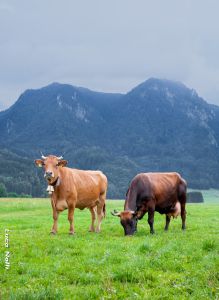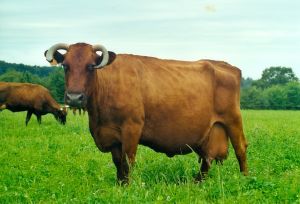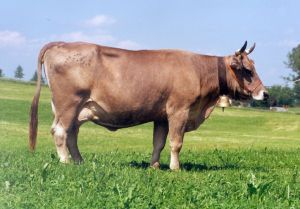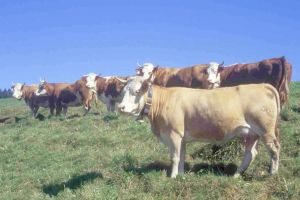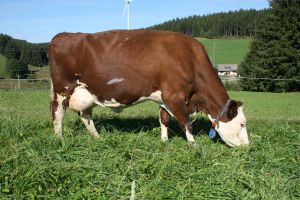Endangered Breeds
German Gelbvieh
Breeding goal
Gelbvieh is a beef-focused dual-purpose breed. It is popular in dairy cattle farming (used in low-input farms) as well as in beef cattle farming. Due to its Franconian origin it is also called yellow Franconian cattle (gelbes Frankenvieh
). It is characterised by good muscling and medium milk yield. A high feed intake capacity in connection with very good meat production, good fertility, easy calving, adaptability and thus a good longevity, strong bones and resistant hooves are its characteristics. Gelbvieh is therefore interesting in pure breeding and in crossbreeding with dairy breeds. The trait of genetic hornlessness is an important breeding goal. A Gelbvieh cow has a height at withers of 138cm - 145cm and a weight of 700kg to 850kg. The height at the withers of adult bulls is between 148cm - 160cm with a weight of 1,100kg to 1,300kg. The average milk yield varies depending on the intensity of use and in 2011 was just under 6,000kg per year for herdbook cows with about 4.2% fat and 3.5% protein. The age at first calving is between 24 and 28 months, the calving interval is 365 days. Young bulls show a long-lasting muscle growth without quality-reducing adiposis and good muscling in the valuable meat parts. With intensive fattening, daily gains of around 1,300g are achievable. In addition, there are high carcass yields of approx. 60% with slaughter weights of around 600kg to 700kg for young bulls. The meat quality is finely fibrous, tender, well marbled and of excellent taste. When used exclusively for meat production, the aim is to have robust cattle with optimal meat performance. The good milk yield of the dams is a requirement for high weaning weights of the calves.
Pinzgauer
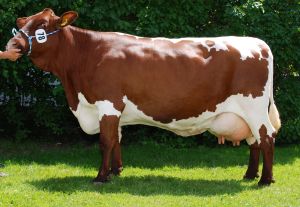
Pinzgauer cows with their distinctive chestnut-brown and white coat markings are also visually very pretty.
Breeding goal
The aim is to breed high performing, framed dual-purpose cattle. Consolidation in frame and muscling is particularly important. In order to improve the profitability, a high intake of the farm grown fodder and a good fertility as well as a good ability to grow and adapt should be given special attention. Furthermore, selection should pay attention to correct, dry limbs with a firm claw and easy-milking, well-attached udders with a strong suspension.
The cows should have an average lactation performance of 5,800kg with 4% fat and 3.5% protein.
In young bull fattening, gains of 1,250g to 1,300g are aimed for, with a very good carcass value and an exploitation of about 58% as well as a high meat content. The superior meat quality achieved so far must be maintained.
The cross height of adult bulls should be around 150cm and of adult cows around 140cm. The weight of adult bulls should reach approx. 1,200kg and of adult cows approx. 750kg.
Description
The basic colour of the coat is chestnut brown, rarely also black. A wedge-shaped back whiteness begins at the withers, spreads to the base of the tail and then changes into a belly whiteness, which extends to the chest. White stripes, called Fatschen (patches), run around the forearms and lower legs.
Distribution
In German-speaking countries, mainly in south-eastern Upper Bavaria, Austria (especially in the province of Salzburg) and worldwide in about 30 countries.
Performance
The milk yield of the 678 herdbook cows in Bavaria in 2019 was 5,743 kg milk, 3.95 % fat, 227 kg fat, 3.35 % protein, 192 kg protein.
The well marbled meat is highly appreciated by gourmets. The breed has good mothering qualities, which is why it is increasingly used in suckler cow husbandry. Pinzgauer bulls have always been appreciated for their ability to grow and their good carcass quality as well as for their good legs and hard claws. The breed also copes well with harsh environmental conditions and is therefore often used for grazing alpine pastures.
Murnau-Werdenfelser
Breeding goal
The Murnau-Werdenfelser - as an old rural breed, so to speak, a Bavarian cultural heritage - shows, in addition to an economical milk and meat production, especially a superior longevity, undemandingness, hardness of the claws and overall robustness of the footwork compared to other breeds. This makes this breed excellently suited for suckler cow husbandry.
Description
The animals are solid yellow to reddish brown, with the bulls often darker than the cows. The mouth and the long hair at the tail are dark, the claws and the horn tips are black. The mouth is also lightly fringed.
Distribution
District of Garmisch-Partenkirchen, the Werdenfelser Land and surrounding districts.
Performance
Frugality, vitality, good fertility and longevity are the outstanding characteristics of this robust old country breed. The milk yield of all tested herdbook cows (352) in 2019 was:
4325kg milk, 3.83% fat, 166kg fat, 3.38% protein, 146kg protein.
Angler Cattle (Red Cattle) old breed
Description
The Angler cattle old breed (o. b.) originates from the North German peninsula Angeln and has been selectively bred since 1879. The breed is characterised by a red solid colour with dark skin pigment, a high performance from grass and mais silage, high protein and fat content in the milk and longevity. There is a good economic ratio of total feed intake to milk yield. The breed is calving easily and is characterised by low calf losses. With a good marching ability due to healthy feet and legs, the breed is excellently suited for grazing in coastal regions. However, it also brings a reliable performance and adaptability in other climatic zones.
Angler cattle o. b. reach a height of 1.26m to 1.42m with a weight of 450kg to 650kg. Compared to other breeds, their feed efficiency is about 15% higher. They are alert and temperamental cattle with a noble appearance. Mostly they have a completely reddish-brown colouring. Occasionally white spots appear on the udder and belly. Some lines have black masks and black legs.
The breed was bred around and after 1900 especially for high fat content, which was also the cause of the later severe population decline when milk quantity became more important than the fat and protein content of the milk. This increased the pressure on the breed and led to massive crossbreeding with Nordic red cattle breeds and the Red Holstein breed. Today, all animals with at least 62.5% old bloodlines belong to the old breed. The population consists of only about 325 cows and is therefore considered an extremely endangered breed.
Performance
Milk:
- fat content of 4.5% to 6%
- protein content of 3.2% to 4.0% (with a particularly high proportion of the kappa-casein variety BB in the population, which has better cheese-making properties than AA)
- good milk yields
Meat:
- short-fibred, tender meat
- low connective tissue content
- good juiciness
- good marbling
In former times, Angler o. b. were also used as working and draught animals.
Distribution
The breed is mainly found in Schleswig-Holstein in the region of Angeln, a peninsula on the Baltic Sea coast. It has been crossed into many other breeds (Harzer Rotvieh, Frankenvieh, Glanrind and others).
Original Braunvieh (Brown Swiss old breed)
Breeding goal
The Original Braunvieh is bred for dual purpose, meaning milk and meat. Thereby, special emphasis is put on the longevity of the animals. The long-living dual-purpose cow should not be too early maturing, but should calve every year. It should have a medium frame, show healthy feet and legs (good claws) and have an easily milkable, textured udder with a well-developed central ligament and correct teats. In addition to a good milk yield, muscling must be given the greatest attention to ensure that animals can be used economically for fattening and slaughter. The animals should show quality meat with a high carcass value. A high farm grown feed intake capacity with a high feed efficiency should be achieved with a large body depth and chest width. As a robust cattle, the Original Braunvieh should be particularly suitable for grazing in the lowlands as well as in the mountains.
In suckler cow husbandry, the long-living Original Braunvieh cow is expected to have a high fertility and good rearing performance; she should also be undemanding. Vital, fast-growing calves should be the typical feature of the Original Braunvieh. They should have a strongly developed suckling instinct from the first hour. The basic requirements for high rearing results and high weaning weights are good mothering traits, such as easy calving, sufficient milk production and a good mothering instinct (immediate acceptance of the calf after birth). The Original Braunvieh animals should show a calm grazing behaviour, have good claws and be easy to handle for the keeper (especially the bulls). The Original Braunvieh bulls should produce optimal crossbred calves when paired with other beef breeds and dairy breeds.
A milk yield of 6,000kg per lactation with 4.0% fat and 3.5% protein is targeted. Milk flow should be 1.8kg/min to 2.8kg/min. In fattening, daily gains of 1,000g to 1,300g are targeted for bulls, and 1,300g and more for calves. Daily gains of 1,100g to 1,250g for male weaners and 950g to 1,100g for females should be achieved. The optimal calving interval is 365 days while 7 or more lactations should be achieved. The cows are ideally 130cm to 140cm tall with a weight of 550kg to 700kg, while the bulls should reach a height at the withers of 145cm to 155cm and a weight of 900kg to 1,200kg.
Two categories are distinguished in the Original Braunvieh:
Cat. A with verified 0% Brown Swiss blood content
Cat. B with verified Brown Swiss blood content of up to 12.5%.
Description
The colour ranges from a solid brown to a solid grey-brown body in the colour gradations from light to dark. The mouth is darkly pigmented with a pale fringe. The claws are dark pigmented.
Distribution
Main distribution area in Germany is in Bavaria and Baden-Württemberg. The number of herdbook cows in Bavaria and Baden-Württemberg is about 880 cows (as of 30th Sep. 2020).
Performance
The breed is long-living, robust, has a good fertility as well as a high basic feed intake capacity. Therefore, the breed is particularly suitable for extensive farms with little use of concentrated feed.
Hinterwälder
Description
The coat colour is yellow and red with varying amounts of white. The body is mottled, spotted or speckled. The underbelly is predominantly white, feet and tail hair mostly white as well, head white and the mouth is usually of light colour. Speckes around the eyes are common. The Hinterwälder cow is adapted to the most difficult conditions of the highest regions of the southern Black Forest in Germany. It is therefore undemanding and copes quite well with poor environmental conditions. The fast growing of the weaners, the tenderness of the meat and the fact that the animals reach a high age with good fertility are remarkable. The bone structure is remarkably fine. The feet and legs are clear, the joints well developed and sufficiently bent.
The breed is well suited for suckler cow husbandry. Thanks to their good milk yield, well-muscled weaners develop, which can either be marketed directly or fattened up.
Adult Hinterwälder cows have a height at withers of 118cm to 122cm and a weight of 380kg to 420kg.
Hinterwälder are kept both in dual purpose (milk and meat) on the dairy farm and for meat on the suckler cow farm. The majority of the animals are now kept on suckler cow farms. In both breeding systems a profitable economic efficiency is achieved by a good utilisation of farm grown fodder in combination with regular conception and very easy births. The milk yield is 3,150kg milk with 3.95% fat and 3.38% protein with mostly extensive husbandry.
About 80% of the slaughter animals are classified in the commercial classes R and better desired by the market.
Breeding goal
In the breeding and husbandry area of the Hinterwälder population, the characteristics developed through special husbandry conditions are systematically enhanced by selection. In order to achieve economic performance in relation to body weight, the aim is to have a frame that is not too large, a long, tonny body, a medium-sized, even, firmly attached, easy to milk and efficient udder. Furthermore, fine, well-developed, normally angled limbs and hard hooves are desired. The cows, which are dairy-oriented but still sufficiently muscled, have a high longevity and good fertility. The breed is used in dairy herds and suckler cow farms. Especially the high robustness and adaptability, the fast growth of young cattle with good meat production, the tenderness of the meat, the low final weights, the remarkably good feed efficiency, the ability to walk and climb in difficult terrain characterise the breed and enable it to be used for dairy and suckler cow husbandry in all difficult areas.
Hinterwälder are used to meagre living conditions and are therefore robust and undemanding and show good mothering qualities.
Furthermore, the spreading of natural hornlessness is aimed at.
Geographical area and size of the breeding population
The breeding association RBW takes care of the Hinterwälder breed in the geographical area of Baden-Württemberg. The main focus is on the highest regions of the southern Black Forest. The breeding population includes all animals registered in the herdbook. Currently (as of 30th September 2020), the breeding population comprises 120 herdbook bulls and a) 347 herdbook dairy cows and b) 1,628 herdbook suckler cows. Animals in category a) are fully covered by the milk recording and serve as mating partners for A.I. bulls. 27 dairy cattle and 201 suckler cow breeders participate in the breeding programme.
Vorderwälder
Breeding goal
Through excellent adaptability to the environmental factors of the Black Forest, such as steep slopes, short vegetation periods and harsh climate, a constitutionally stable, forage tolerant, grazing, dairy-oriented dual purpose cow of the landrace type should be aimed at. High economic efficiency is achieved by a good intake capacity for the farm's own forage, good fertility, high longevity, an easily milkable, efficient, firmly attached, even udder with correct teat position. The feet and legs must be good, the joints well developed and sufficiently bent, the hoof horn must be hard.
The breed is suitable for suckler cow husbandry due to its good grazing ability and resistance, growth capacity and muscling, its high digestive performance and adaptability. Finally, this results in a good milk production, which is a necessary factor for good weaners. Furthermore, the aim is to spread genetic hornlessness.
- Milk production: Average annual production: 6,000kg milk at 4% fat content and 3.65% protein content.
- Meat production: daily gain in young bulls: at least 1,100g; daily gain in male weaners: at least 1,200g.
- Fertility: 7 calves, average calving interval 380 days.
- Height at withers: adult cows: 135cm - 138cm; adult bulls: 140cm - 150cm
- Weight: adult cows: 550kg - 650kg; adult bulls: 950kg - 1,050kg
- Colour and markings: reddish-pied to reddish animals with white heads and reddish marks on the head.
It is important that the size and weight of the animals remain in a medium range. This is the only way to ensure the usual grazing suitability in the main area of distribution.
Geographical area and size of the breeding population
The breeding association RBW takes care of the Vorderwälder breed in the geographical area of Baden-Württemberg and Bavaria. The central focus is the southern and central Black Forest. The breeding population currently (as of 30th September 2020) comprises 160 herdbook bulls and a) 5,406 herdbook dairy cows and b) 1,351 herdbook suckler cows. Animals in category a) are fully subject to milk recording and serve as mating partners for the A.I. bulls. 246 dairy cattle breeders and 128 suckler cow breeders participate in the breeding programme.
Further information on endangered breeds can be found at the ASR, the RBW and the Angler a. Z. network websites.

